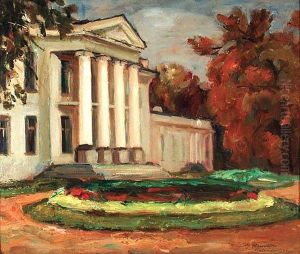Jerzy Hewelke Paintings
Jerzy Hewelke was a Polish artist, whose work spanned several disciplines including painting, graphic art, and stage design. Born in 1902, Hewelke developed his artistic talents in the interwar period, a time of significant cultural flourishing in Poland. Despite the challenges posed by the geopolitical upheavals of the 20th century, including the devastation of World War II and the subsequent imposition of Communist rule in Poland, Hewelke's career reflects the resilience and adaptability of the artistic spirit.
Hewelke's early work was influenced by the avant-garde movements of the early 20th century, incorporating elements of Expressionism and Cubism. He was known for his bold use of color and dynamic compositions, qualities that made his work stand out in the Polish art scene. Throughout his career, Hewelke explored various themes, from landscapes and urban scenes to more abstract compositions, demonstrating a versatility and depth of artistic vision.
During the 1950s and 1960s, Hewelke's work evolved in response to the changing political and cultural landscape in Poland. He engaged with the Socialist Realism style, which was promoted by the Communist government, but also managed to infuse his work with a sense of individuality and critique. This period saw him balancing official commissions with more personal, experimental projects.
In addition to his contributions to painting and graphic art, Hewelke was also active in the world of theater, designing sets and costumes for numerous productions. This aspect of his career highlighted his multifaceted talents and his ability to collaborate with other artists and creatives.
Jerzy Hewelke passed away in 1979, leaving behind a rich legacy of artistic innovation and cultural contribution. His work continues to be celebrated for its vibrancy, technical skill, and the unique perspective it offers on the turbulent history of 20th-century Poland.
